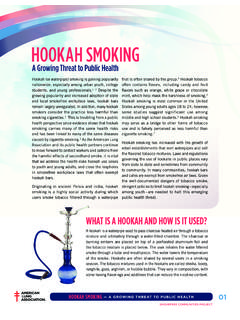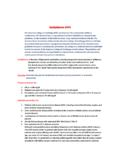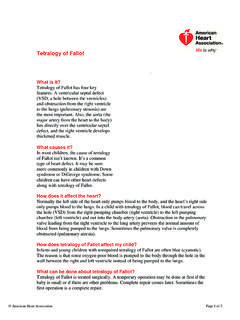Transcription of Anatomy and Physiology - Understanding the …
1 2006 american Heart association 1 Anatomy and Physiology : Understanding the importance of CPR Overview This document gives you more information about the body s structure ( Anatomy ) and function ( Physiology ). This information will help you better understand and remember CPR after your class is over. Three Body Systems All organs need oxygen to function. Three body systems work together to be sure that organs of the body have enough oxygen: respiratory system (brings oxygen in and takes waste out) cardiovascular system (moves blood and oxygen around) nervous system (tells organs what to do and when) How These Systems Work Together The respiratory, cardiovascular, and nervous systems work together to maintain life.
2 The lungs put oxygen in the blood, and the heart delivers oxygen-rich blood to the heart itself and to the brain and other organs. What Happens When These Systems Fail When these systems fail, the process of dying begins. If oxygen delivery to the organs stops because an airway is blocked or normal breathing or circulation stops, the brain and other organs will begin to die within minutes. How CPR Helps The miracle of CPR is that it can help save the life of a dying person with 2 simple actions: Delivering breaths to the victim s lungs Compressing the victim s chest The Respiratory System: Airways, Lungs, and Muscles Anatomy of the Respiratory System The respiratory system (Figure 1) has 4 parts.
3 The airways that conduct air between the outside and the lungs the air sacs (alveoli) in the lungs where gas exchange happens 2006 american Heart association 2 the nerves that tell the muscles when to move and the muscles that let the air move in and out a set of blood vessels that move the blood to the organs and removes waste from the blood Airway The airway can be divided into the upper airway and the lower airways: Upper Airway Lower Airways Nose and mouth Pharynx (behind the tongue) Larynx (voice box) Trachea (windpipe) Bronchi (1 bronchus to the right lung and 1 to the left lung) Bronchioles (branches of the bronchi that terminate in the alveoli) Figure 1.
4 Anatomy of the respiratory system. Alveoli Alveoli are at the end of the airways. Oxygen can quickly move from the air sacs into the blood, and carbon dioxide moves from the blood into the air sacs. Blood that carries oxygen then flows back to the heart and is pumped to the body. Carbon dioxide from the air sacs moves out of the lungs into the air. Neuromuscular Component 2006 american Heart association 3 The neuromuscular component of the respiratory system includes the brain the nerves to and from the muscles for breathing the muscles of breathing The major muscles of breathing are the large diaphragm attaches to the margin of the lower ribs separates the chest from the abdomen the muscles between the ribs some muscles of the neck and shoulder Arteries, Capillaries, and Veins The following table describes the functions of pulmonary arteries, capillaries, and veins.
5 Part Function Pulmonary Arteries Carry blood with relatively low oxygen content from the right side of the heart into the capillaries surrounding the alveoli. Pulmonary Capillaries Create a web surrounding the alveoli. At the interface between the capillaries and the alveoli, oxygen moves from the alveoli into the capillaries and carbon dioxide moves from the capillaries into the alveoli. Pulmonary Veins Carry blood with high oxygen content from the lungs back to the left side of the heart. Physiology of the Respiratory System The respiratory system has two primary functions: bringing oxygen from the air to the alveoli where it can move into blood eliminating carbon dioxide that moves from the blood into the alveoli All body cells need a continuous supply of oxygen to function.
6 Metabolism (the work of the cells) produces carbon dioxide, which the body must eliminate. Avoiding Too Many Breaths During CPR During CPR, blood flow to the lungs is only about 20% to 33% of normal, so fewer breaths and smaller air volume is needed to provide oxygen and eliminate carbon dioxide during cardiac arrest than when the victim s heart is working normally. 2006 american Heart association 4 When performing CPR, rescuers must pause compressions to give breaths. During these pauses there is no blood flow to the heart muscle and brain. To minimize effects on blood flow, the rescuer should try to deliver the 2 breaths as efficiently as possible to minimize the time the compressions are interrupted.
7 If a rescuer gives too many breaths or gives the breaths over several seconds, the rescuer will deliver fewer compressions than recommended. In that case, blood flow will be even less than the 20% to 33% of normal that is typically generated by CPR. Cardiovascular System The 2 primary functions of the cardiovascular system are: carrying oxygenated blood from the lungs to the cells of the body carrying blood containing carbon dioxide from the cells of the body to the lungs In most healthy people the levels of oxygen and carbon dioxide in the blood remain relatively constant. The respiratory center of the brain tells the body to breathe.
8 When the level of carbon dioxide rises, the following process happens: The brain sends signals to the muscles of breathing. Breathing rate and depth increase. The signals sent by the breathing center in the brain decrease. The breathing rate slows. The blood level of carbon dioxide is maintained in a narrow range. Oxygen Content The air around us usually contains about 21% oxygen and 79% nitrogen. Because only about a quarter of the oxygen in inhaled air is taken up by the blood in the lungs during respiration, exhaled air still contains a significant concentration (about 16%) of oxygen. When giving breaths during CPR, the air exhaled by the rescuer and delivered to the victim contains a sufficient amount of oxygen to give enough oxygen to the victim.
9 Mechanics of Breathing Inspiration (breathing in) is an active process, while exhalation (breathing out) is generally a passive process. The diaphragm is the chief muscle of 2006 american Heart association 5 inspiration. The following list shows the process of breathing: Two sets of muscles contract at the same time the diaphragm and the muscles between the ribs (the intercostal muscles). The diaphragm contracts and moves down toward the abdomen, increasing the volume inside the chest. The intercostal muscles contract and lift the rib cage, further increasing the volume inside the chest. When the volume in the chest increases, the pressure in the chest and lungs falls.
10 The difference in pressure between the outside air and the lungs draws air into the lungs. As the muscles relax, the ribs move down and the diaphragm rises, reducing the volume of the chest cavity. The elastic lung passively becomes smaller, and the air inside the lung moves out (exhalation). Airway Blockage Airway blockage, particularly choking, is presented in detail in the student workbook. The most common cause of airway blockage in the victim who does not respond is blockage by the tongue. Any condition that leads to the victim not responding can cause the tongue to fall toward the back of the throat and block the airway. Death caused by airway blockage is relatively uncommon ( deaths per 100 000) in the United However, the need for proper emergency action in cases of choking is of key importance for safety at home, in restaurants, and in other public places.





